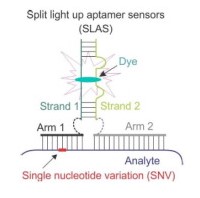Authors: Yulia V.Gerasimova, Nedorezova D.D.,

Abstract
Aptamers that bind non-fluorescent dyes and increase their fluorescence can be converted to fluorescent sensors. Here, we discuss and provide guidance for the design of split (binary) light up aptameric sensors (SLAS) for nucleic acid analysis. SLAS consist of two RNA or DNA strands and a fluorogenic organic dye added as a buffer component. The two strands hybridize to the analyzed DNA or RNA sequence and form a dye-binding pocket, followed by dye binding, and increase in its fluorescence. SLAS can detect nucleic acids in a cost-efficient label-free format since it does not require conjugation of organic dyes with nucleic acids. SLAS design is preferable over monolith fluorescent sensors due to simpler assay optimization and improved selectivity. RNA-based SLAS can be expressed in cells and used for intracellular monitoring and imaging biological molecules.
Read full: https://www.sciencedirect.com/science/article/pii/S1046202321001341